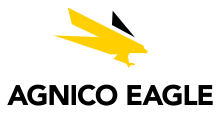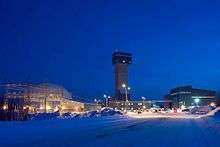Agnico Eagle Mines Limited
 | |
| Public | |
| Traded as |
TSX: AEM NYSE: AEM S&P/TSX 60 component |
| Industry | Mining & Gold Producers & Products Manufacturing |
| Founded | 1953 as Cobalt Consolidated Mining Company |
| Founder | Paul Penna |
| Headquarters | Toronto, Ontario, Canada |
Key people |
James D. Nasso (Chairman of the Board) Sean Boyd (CEO) |
| Revenue |
|
|
| |
|
| |
| Total assets |
|
| Total equity |
|
Number of employees | 5500 (Dec 2012)[1] |
| Subsidiaries |
Agnico-Eagle USA Agnico-Eagle Mexico Agnico-Eagle Sweden Riddarhyttan Resources |
| Website | AgnicoEagle.com |
Agnico Eagle Mines Limited is a Canadian-based gold producer with operations in Canada, Finland and Mexico and exploration and development activities extending to the United States. Agnico Eagle has full exposure to higher gold prices consistent with its policy of no-forward gold sales. It has paid a cash dividend for 29 consecutive years as of 2010.
History
In 1953, five struggling mining companies joined together to become Cobalt Consolidated Mining, which would last until 1957, when the company changed its name to Agnico Mines. “Agnico” is derived from the periodic table of elements using the symbols for silver (Ag), nickel (Ni) and cobalt (co).[2] In 1963, visionary Paul Penna became the president of Agnico Mines, and he eventually oversaw the merger of Agnico Mines with Eagle Mines Ltd, a successful gold exploration company, enabling the development of Eagle’s Joutel mining complex. The newly formed company became Agnico Eagle Mines Limited.[2]
In 1974, the Joutel mine went into production and would eventually produce approximately 1.1 million ounces of gold until its closure in 1993. During this period, Agnico Eagle also acquired the property and assets of Dumagami Mines Limited in north-western Quebec, which had recently gone into production a year earlier in 1988. The Dumagami mine would eventually be renamed the LaRonde mine, which is now considered the flagship mining operation for Agnico Eagle, and one of the largest gold deposits in Canada. With LaRonde producing steadily, Agnico Eagle acquired more assets over the following years.[2]
In 1993, they completed the purchase of the Goldex mine, becoming the 100% owner of the largest unexploited gold deposit in Quebec. This was followed by the purchase of the Lapa gold deposit in 2000, Riddarhyttan Resources AB (the 100% owner of the Suurikuusikko gold deposit in northern Finland, which would become the Kittilä mine) in 2005, the Pinos Altos project in Mexico in 2006, and the purchase of Cumberland Resources in 2007, giving Agnico Eagle 100% control of the Meadowbank gold project in Nunavut, Canada.[2]
As a result of these purchases, the following years would see Agnico Eagle grow from a single-operation gold producer (LaRonde) to a much larger company consisting of 6 mines in total, with Goldex going into production in 2008, Kittila, Lapa and Pinos Altos in 2009, and Meadowbank in 2010.[2] In 2010, Agnico Eagle completed the purchase of the Meliadine property, located southeast of Meadowbank near Rankin Inlet, Nunavut. In 2011, the company also announced a $70 million (CAD) investment in Rubicon Minerals, representing a 9.2% ownership stake and access to the Phoenix gold project located in the heart of Red Lake, Ontario.[2]
Operations
LaRonde
The LaRonde mine, located in Quebec, Canada, employs 735 people. It has the longest estimated mine life out of Agnico Eagle’s 6 operating mines, estimated to be approximately 35 years once completed, from 1988 to 2023. LaRonde is an underground mine with the deepest single-lift shaft in the western hemisphere, descending 2.25 km below the surface. An expansion is also planned, and upon its completion, the total mine depth will be over 3 km deep, making the LaRonde mine one of the deepest mines in the Americas.[3]
Goldex

Employing 213 people, with an estimated mine life of 10 years (2008-2018); Goldex is an underground mine located just outside Val-d’Or, Quebec, Canada. Goldex is unique because of its partnership with the Quebec government in the restoration of the nearby abandoned Manitou mine tailings site. Through an innovative approach, the tailings from the Goldex mine are sent through a 25 km long pipeline to the Manitou site where they neutralize the acidic waters in the area, the result of years of poorly confined tailings generated between 1942 and 1979 by the mining companies operating the Manitou project at the time. Not only do the Goldex tailings neutralize and help rehabilitate the site, the system eliminates the need for a tailings pond at the Goldex site itself.[3]
Lapa
Lapa, located about 11 km away from the LaRonde mine (see above), in the Rivière-Héva municipality of the Abitibi region in Quebec, Canada, is one of Agnico Eagle’s smaller operations employing 192 people, with a 6-year mine life expectancy (2009-2015). The main headframe that is used at the Lapa mine was constructed almost entirely from a pre-existing headframe at LaRonde. The original headframe was dismantled, sand blasted and painted before it was installed at Lapa. Although Lapa may be a smaller operation in comparison to our other mines, it is one of Agnico Eagle’s highest-grade mines, with reserve grades twice as rich as the company average.[3]
Kittilä

In the Lapland region of Northern Finland, Agnico Eagle’s Kittila operation has a life expectancy of 23 years (2009 – 2032). With 375 employees, this open pit and underground mine is one of the largest known gold deposits in all of Europe, containing almost 4.9 million ounces of gold in reserves. Aggressive exploration is also currently underway; with the Kittilä mine serving notice that gold-mining is again a booming industry in northern Finland.[3]
Pinos Altos
Agnico Eagle’s largest employer, with 972 employees, is the Pinos Altos mine located in the state of Chihuahua, in northern Mexico. Pinos Altos began operation in 2009 and is expected to continue until 2026, resulting in an estimated 17 years of production. The open-pit and underground mining operation is in the mountainous Sierra Madre gold and silver belt of northern Mexico.[3]
Meadowbank
Meadowbank is an open-pit mine in the Kivalliq Region of Nunavut with a 8-year life expectancy (2010 – 2017). Meadowbank is Agnico Eagle’s most recent mine to begin operation, and has about 650 employees. In 2010 the first gold brick was poured at Meadowbank, which was also the first ever gold brick to be poured in the history of Nunavut. Meadowbank is also Agnico Eagle’s largest producer, estimated to produce 430,000 ounces of gold in 2014.[3]
Exploration
The 2011 exploration program is expected to include more than 410 km of planned drilling to expand resources and convert our large gold resource to reserves.[4] Major programs are planned at the following locations:
Meliadine – 90,000 meters of diamond drilling, an underground bulk sample, new permanent accommodations at the exploration camp, permitting infrastructure upgrades.[4]
Kittilä – 56,200 meters of exploration and conversion drilling, and construction of an exploration ramp to accelerate the definition of resources and facilitate additional exploration at depth.[4]

Goldex – 58,200 meters of diamond drilling will principally target resource expansion for the D zone. Pending the results of a planned mining study in 2011, a reserve conversion program will also be considered.[4]
LaRonde/Bousquet/Ellison – 42,050 meters of drilling, which includes a follow-up exploration program for Ellison.[4]
Pinos Altos – 33,800 meters of drilling including minesite (reserve conversion) and regional (resource expansion) drilling, and an underground exploration program and scoping study for the Cubiro zone.[4]
Meadowbank – 32,000 meters of conversion and exploration drilling targeting extensions of the Vault deposit and underground potential beneath Goose South.[4]
In December 2016 Agnico invested CA$4.5 million into Canadian junior mining company Cartier Resources to conduct exploration on the Chimo, Benoist, Wilson, Fenton and Cadillac Extension projects in Quebec.[5]
References
- 1 2 3 4 5 6 "Agnico-Eagle Mines Ltd 2008 Annual Report" (PDF). Retrieved 2009-04-30.
- 1 2 3 4 5 6 "Agnico-Eagle Our Company - History". Retrieved 24 August 2011.
- 1 2 3 4 5 6 "Operating Mines". Agnico-Eagle Mines Limited. Retrieved 24 August 2011.
- 1 2 3 4 5 6 7 "Financial Reports". Agnico-Eagle Mines Limited. Retrieved 24 August 2011.
- ↑ "Junior Mining Network". Junior Mining Network. Retrieved 22 December 2016.
Further reading
- Vos mines vous parlent. 2013 onwards. Montréal: Québécor media. N.B.: "1ère éd., 10 avril 2013". Without ISSN